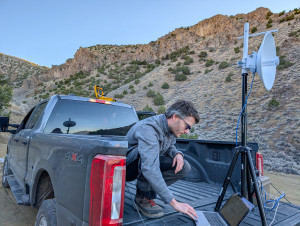Wireless Testing and Technology Evaluation
Advice supporting sensor wireless backhaul technologies and choices for different use cases
There are many options for wireless connectivity. The availability of non-terrestrial constellations, such as Starlink, Kuiper and others, among many other emergent technologies, illustrates how much the landscape of wireless options is changing.
Modern field sensor system wireless network subsystems tend to be built around multiple wireless technologies supporting local and wide area needs. Accordingly, the challenge for science programs is not "what wireless technology should we use" but "what mixture of capabilities should we knit together and how" as workflows increasingly involve both short- and long- range data movement needs.
For example, a particular remote sensor site location may be used by multiple sensors, operated by multiple teams, as part of collecting information on hydrology, seismic, or natural resources. These sensors may use a variety of mesh-network, short range wireless, or wifi to provide information via a local area wireless network to one or more data loggers at the site. Each of these sensors may be constrained by power, placement or budget limits

At the same time, medium range private cellular (CBRS in this case) may also be needed in the area to support both operational needs (ability for scientists in the field to communicate, drones, etc) as well as provide expanded local coverage to sensors which may be proximate but not within immediate line-of-site.
Finally, remote sensor sites will need access to wide area networks (WAN) such as commercial cellular, non-terrestrial networks, to move data to Labs, data portals, etc. Often this is provided at LAN/WAN interface sites, given that it is not economical, or electrical power may not exist, to provide each sensor area with its own wide area interface.
In some cases, as above, traffic from these WAN resources may transit over commercial satellite or cellular services. In other cases, there may be a local wired network point of presence. In either case, ESnet can leverage existing peering we have with many commercial capabilities, or our REN partnerships to ensure efficient transit solutions.
In cases where a new capability, such as free-space optics, or mmWave, needs to be brought into the solution-mix, ESnet can collaborate with you to test, evaluate and tune capabilities as needed - and we are often trying out new technologies to see where we can fit them into solutions for science workflows.

RF Measurement and directional Wi-Fi evaluation


